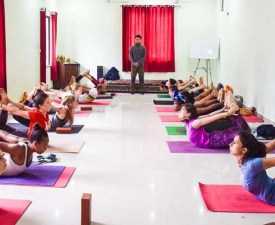Description
Course Name: Diploma in Yoga Teacher Training
Course Id: DYTT/Q0001.
Education Qualification: 10th Class.
Duration: 370 Hrs.
How You will Get Diploma Certificate:
Step 1- Select your Course for Certification.
Step 2- Click on Enroll Now.
Step 3- Proceed to Enroll Now.
Step 4- Fill Your Billing Details and Proceed to Pay.
Step 5- You Will be Redirected to Payment Gateway, Pay Course and Exam Fee by Following Options.
Card(Debit/Credit), Wallet, Paytm, Net banking, UPI and Google pay.
Step 6- After Payment You will receive Study Material on your email id.
Step 7- After Completion of Course Study give Online Examination.
Step 8- After Online Examination you will get Diploma Certificate soft copy(Scan Copy) and Hard Copy(Original With Seal and Sign).
Step 9- After Certification you will receive Prospect Job Opportunities as per your Interest Area.
Online Examination Detail:
- Duration- 120 minutes.
- No. of Questions- 60. (Multiple Choice Questions).
- 10 Questions from each module, each carry 10 marks.
- Maximum Marks- 600, Passing Marks- 40%.
- There is no negative marking in this module.
| How Students will be Graded: | ||
| S.No. | Marks | Grade |
| 1 | 91-100 | O (Outstanding) |
| 2 | 81-90 | A (Excellent) |
| 3 | 71-80 | A (Very Good) |
| 4 | 61-70 | B (Good) |
| 5 | 51-60 | C (Average) |
| 6 | 41-50 | P (Pass) |
| 7 | 0-40 | F (Fail) |
Benefits of Certification:
- Government Authorized Assessment Agency Certification.
- Certificate Valid for Lifetime.
- Lifetime Verification of Certificate.
- Free Job Assistance as per your Interest Area.
Syllabus
Diploma In Yoga Teacher Training
Human Science for Yogic Practice
Foundation of yogic science, basics relevant to yogic science, human biology, yoga for personal health, basics of integral approach to yogic, basic principles of yoga therapy, modern approach of health system, yoga therapy practices, bandhas and mudras, pranayama & meditation, scientific approach of yoga, basics of jnanayoga, basis of yoga and spirituality, yoga and spirituality for health.
Yoga Introduction
Types of yoga, benefits of power yoga, power yoga, vinyasa yoga, yin yoga, hatha yoga, ashtanga yoga, benefits of ashtanga yoga, cerebral blood flow changes, . Efficacy to builds muscle strength, betters your bone health, boosts immunity, perfects your posture – improves your balance, consciousness – helps you focus, relaxes your system, helps you sleep better, improves your flexibility, releases tension in your limbs, prevents cartilage and joint breakdown.
Practical of Yoga Postures
Sun salutation, shooting bow posture, salutation pose, half moon posture, half moon posture, restrained angle posture, child posture, wheel posture, bow posture, one legged posture, half spinal twist posture, cow face posture, plough posture, hand – foot big toe pose, fish posture, cobra posture, king of the dance posture, lotus posture, turned side angle posture, wind – releasing posture, shoulder stand posture, locust posture, corpse posture, accomplished posture, lion posture, headstand posture, mountain pose, triangle pose, powerful posture, camel posture, diamond posture, hero posture, tree pose, scorpion pose.
Pranayamas & Mudras
Vishnu mudra, chin mudra, jnana mudra, chinmaya mudra, aadi mudra, brahma mudra, bhairava and bhairavi mudra, pranavayu mudras, history of pranayamas, content of pranayamas, spiritual aspect of pranayamas, progressive pattern of pranayamas, varieties of pranayamas, therapeutic application of pranayamas, and related breathing, anulom-vilompranayamas, ujjayipranayamas, suryabhendanapranayamas, bhramaripranayamas, shitalipranayamas, sitkaripranayamas.
Remedial Therapy of Diseases
Adhd (attention deficit hyperactivity disorder), specific learning disabilities (dyslexia, dyscalculia, dysgraphia), global developmental delay (gdd), mild to moderate intellectual disabilities, autism spectrum disorder (asd), children with emotional and behavioural issues, their age, frequency of therapy, underlying medical condition, type and severity.
Teaching Method of Yoga
Keep yourself balanced, demonstrate and explain in detail, incorporate the art of breathing, design your class around your students, engage in effortless communication, commit fully to your own practice, karma yoga – path of self sacrifice, bhakti yoga – path of self surrender, jnana yoga – path of self analysis, raja yoga – path of self control. The nature of all yogic practices is psycho-physiological.

